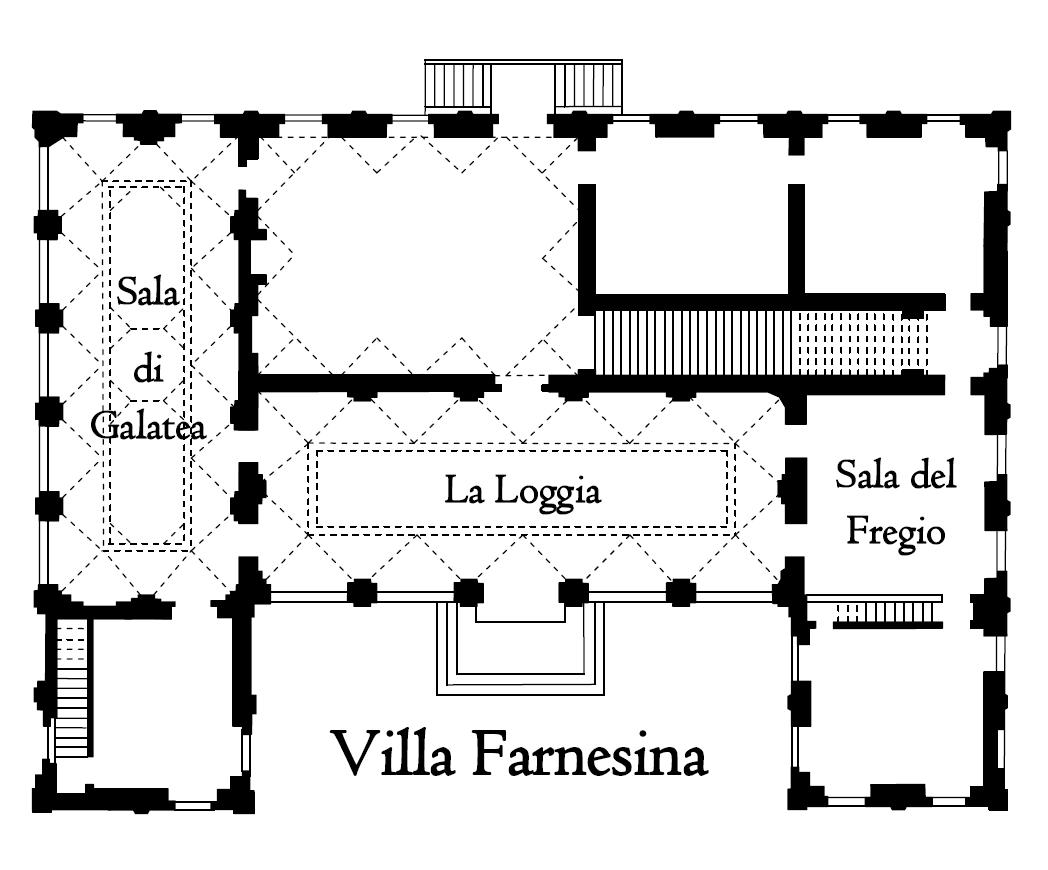To see an excellent example of Renaissance architecture in Italy, one should visit the Villa Farnesina. It can be found in the green Trastevere area of Rome on the Via della Lungara along the Tiber River. The rectangular structure represents the concept of the Renaissance perfectly which is why it is so important to architecture even today.
 |
| Exterior view of the villa |
The villa was built for a wealthy Sienese banker, Agostino Chigi, and went by the name Villa Chigi. Construction for the building began in 1509 by Baldassarre Peruzzi, an architect and painter, who was responsible for the design and construction. While the exterior was finished in 1511, the interior decorating lasted until 1519. This was because Chigi was an active patron and lover of the arts and wanted the villa to reflect that as much as possible. The location of the villa also worked to Chigi’s advantage as it was not too far from the city center and as a result, he was able to entertain high prelates, noblemen and cardinals. In fact, even the pope himself visited the villa. 5
 |
| Plan of Villa Farnesina |
One of the things that Chigi made sure to include in the villa is a large garden. The large garden helps the theme of “clean architecture” one sees when looking at the Villa Farnesina. The design of the building is fairly similar and symmetrical as it just a rectangle. The cross section of the building is a square and the main section shows the large rectangle that is essentially two squares. This two square proportion is repeated in the dimensions of the doors and windows throughout the villa except in the mezzanine. 3
Decorating the exterior of the building can be found monochrome frescos that were done by Raphael who was a good friend of Peruzzi. In fact, Raphael was commissioned to decorate the loggia and other things in the villa in 1517. He also had his pupils Giulio Romano, Francesco Renni, Raffaellino del Colle and Giovanni de Udine help him in decorating the villa. The frescos help support the nature theme throughout the exterior of the building. The painting sale can be seen to imitate Roman marble reliefs to give the feel of an ancient monument which is an interesting touch. 1
 |
| Triumph of Galatea |
One of the main features of Villa Farnesina is the Loggia of Galatea that was done by Raphael. The loggia can be found on the ground floor of the villa through an entrance hall. It depicts the classical and secular myths of Cupid and Psyche and the Triumph of Galatea. The nymph Galatea is on a shell being pulled by dolphins and inspiration for this scene came from a poem by Angelo Poliziano. 1
 |
| Hall of Galatea |
The Loggia of Psyche is also filled with great artwork. The frescoed images of the groups of collective gods and individual gods have been done by Raphael’s pupils. Mythology was important to these individuals and as a result, the fresco reflects that.
After Chigi’s death in 1520, the villa was bought by Cardinal Alessandro Farnese, from whom the villa takes it’s present name. In 1714, it became property of the bourbon family and then was bought by the Spanish Ambassador Bermudez de Castro not long after that. In 1928, it was bought back from the Duke’s heirs by the Italian state and then became open to the public for viewing. 2
While a plan or section of Villa Farnesina might not look like much because of the simple geometry, there is a great amount of art work that is decorating the exterior as well as the interior. It also serves as a collection of great paintings seeing that so many different painters and artists contributed, each adding their own style.
Works Cited
1 D’Ancona, Paolo. The Farnesina Frescoes at Rome. Italy: Edizioni Del Milione, 1956.
2 Hibbert, Christopher. "Rome: Biography of a City." London: Penguin Books, 1985.
3 Hunt, Patrick. "Villa Farnesina, Jewel of Renaissance Rome." Electrum Magazine RSS. N.p., 14 June 2012. Web. 03 Dec. 2016.
4 Millard, George. "Rome." New York: Oxford University Press, 1961.
5 Johnston, David E. "Roman Villas." London: Shire Publications, 1988.
3 Hunt, Patrick. "Villa Farnesina, Jewel of Renaissance Rome." Electrum Magazine RSS. N.p., 14 June 2012. Web. 03 Dec. 2016.
4 Millard, George. "Rome." New York: Oxford University Press, 1961.
5 Johnston, David E. "Roman Villas." London: Shire Publications, 1988.
No comments:
Post a Comment